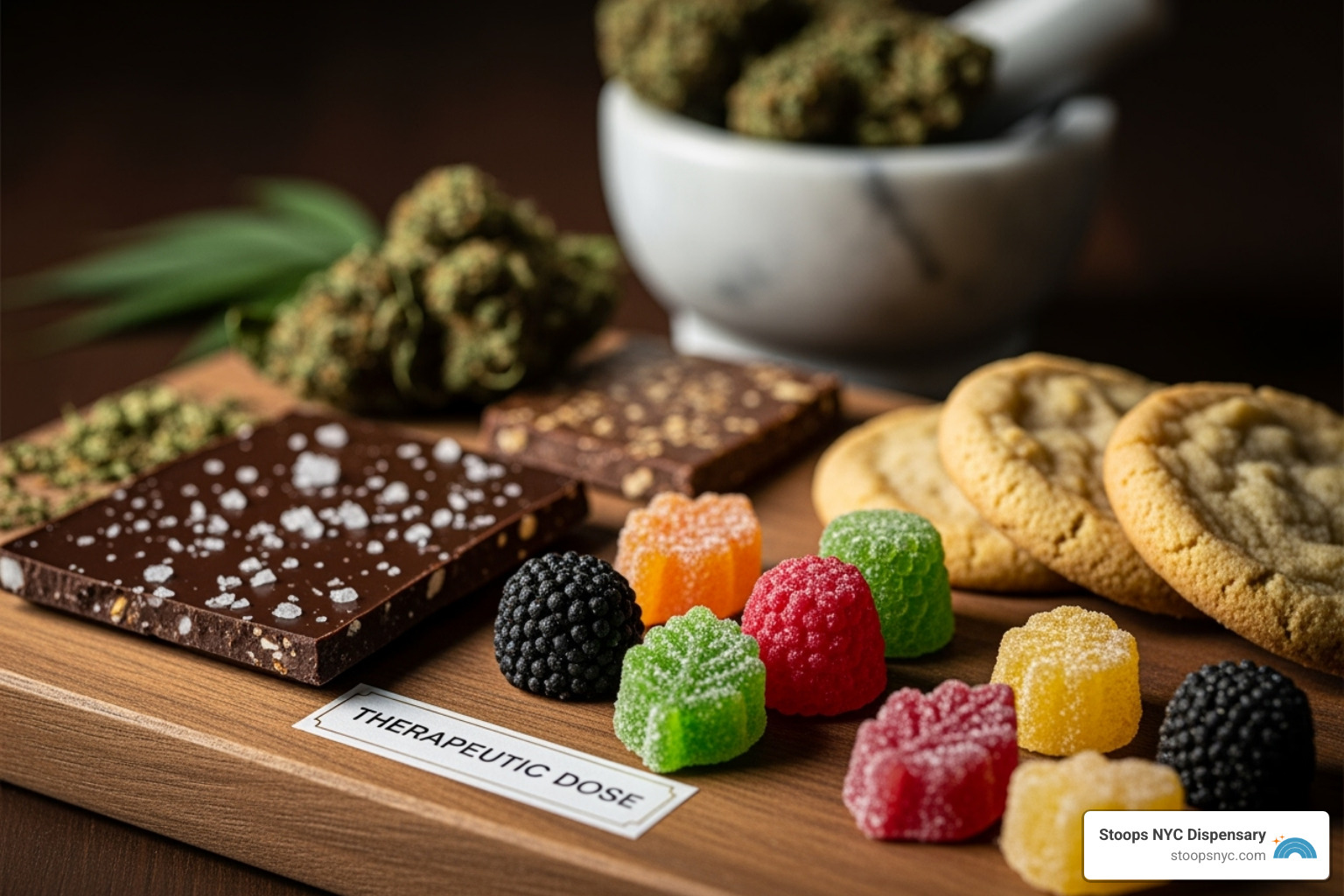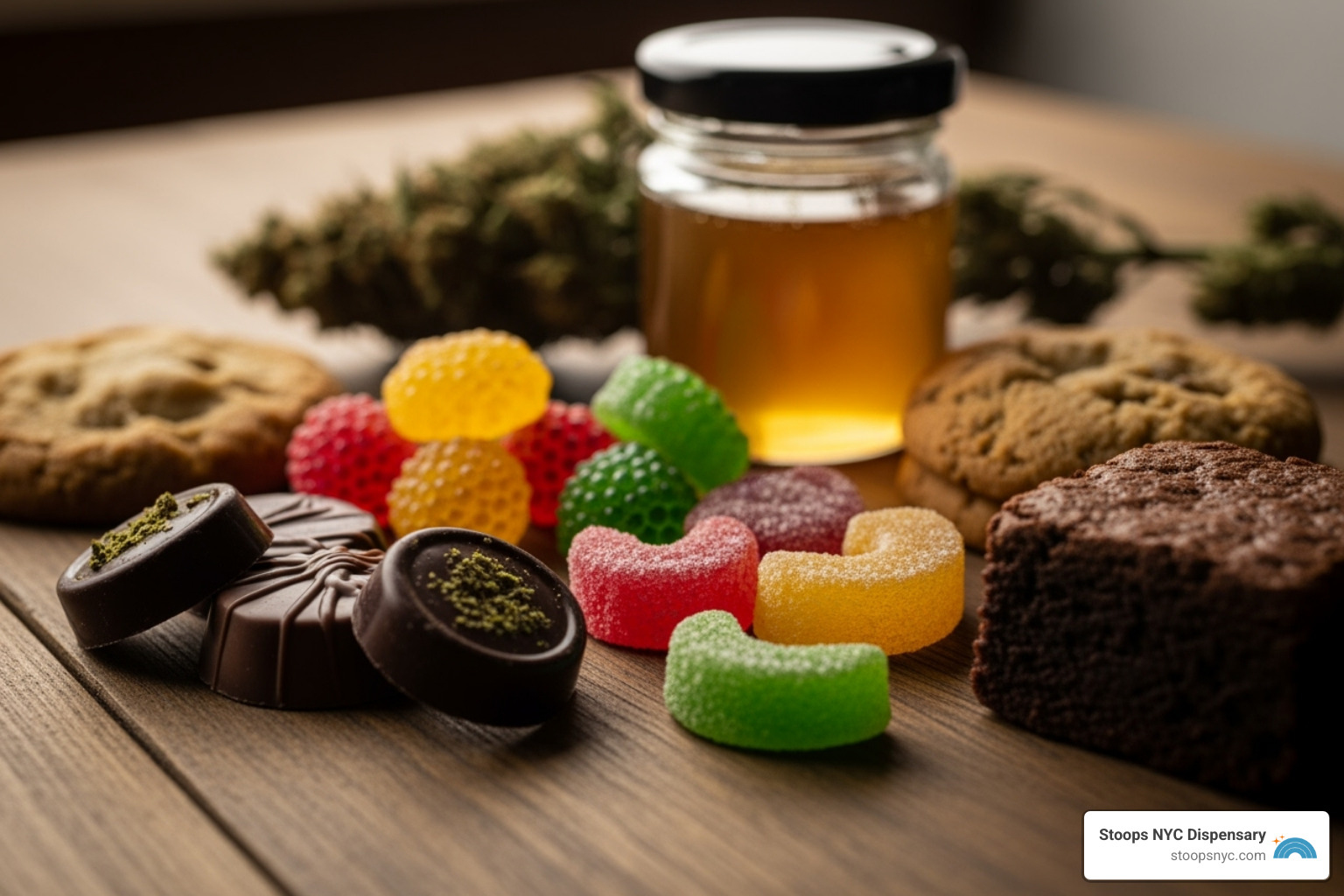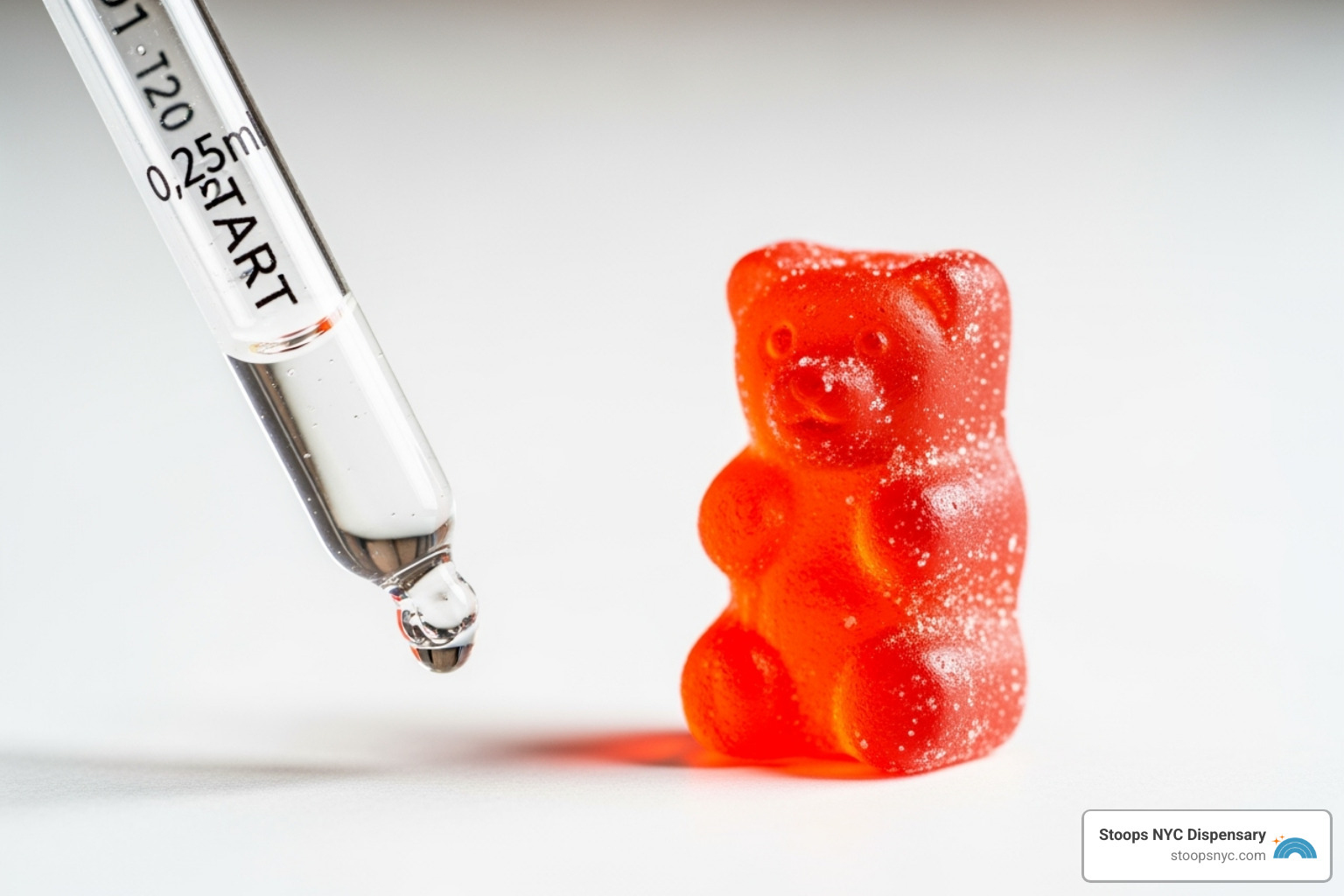Why Cannabis Edibles Are Changing Pain Management
Edibles for pain are becoming a game-changer for millions of Americans seeking relief from chronic discomfort. With nearly 50 million Americans suffering from chronic pain, many are turning to cannabis-infused foods as a natural alternative to traditional pain medications.
Quick Guide to Edibles for Pain Relief:
- Best cannabinoid ratios: 1:1 THC:CBD for balanced relief, high-CBD for minimal psychoactive effects
- Onset time: 30 minutes to 2 hours (slower than smoking but longer-lasting)
- Duration: 4-6+ hours of sustained relief
- Starting dose: 2.5-5mg THC for beginners
- Top types: Gummies for precise dosing, chocolates for longer effects, tinctures for flexibility
Unlike smoking or vaping, edibles work through your digestive system. When you eat a cannabis gummy or chocolate, your liver converts THC into 11-hydroxy-THC – a more potent compound that provides extended relief. Research shows that 81% of medical cannabis users agree that cannabis is more effective alone than combined with opioids, while 97% say they can decrease opioid usage when taking cannabis.
The key advantage? Edibles offer discreet, long-lasting pain relief without the risks of smoking. They’re perfect for managing chronic conditions like arthritis, fibromyalgia, and nerve pain throughout your day.
As Chris Kuilan, Co-Founder of Stoops NYC, I’ve spent nearly two years helping Manhattan residents steer edibles for pain relief through our community-focused approach to cannabis education. Our “Farm to Stoop” philosophy ensures you get high-quality, locally-sourced options that actually work for your specific pain needs.

Edibles for pain vocab explained:
How Do Cannabis Edibles Work for Pain Relief?
Your body’s Endocannabinoid System (ECS) is a natural pain management network that uses receptors and cannabinoids to regulate mood, sleep, appetite, and pain signals. When you consume edibles for pain, cannabinoids like THC and CBD support the ECS, enhancing its effectiveness.
THC (tetrahydrocannabinol) binds to CB1 receptors in the brain and nervous system, reducing pain signals and boosting dopamine. CBD (cannabidiol) targets CB2 receptors in the immune system to fight inflammation, a major cause of chronic pain. When you eat an edible, cannabinoids travel through your digestive system to the liver. There, THC is converted into 11-hydroxy-THC, a more potent compound that provides longer-lasting relief than smoking or vaping.
Scientific research on chronic neuropathic pain backs this up, showing promising results for cannabis as an effective pain reliever. Studies have found a clear connection between THC dose and short-term pain relief, proving that both THC and CBD play important roles in managing discomfort.
The Science Behind Ingestion

Unlike smoking, edibles for pain are processed through the digestive system. The stomach, small intestine, and liver absorb and process the cannabinoids, which is why effects are delayed by 30 to 90 minutes. Patience pays off. The liver’s conversion of THC to 11-hydroxy-THC provides sustained relief for 4 to 6+ hours, making edibles ideal for all-day or all-night chronic pain management.
The biggest mistake is impatience. To avoid overconsumption, wait for the effects before taking more. Start small and be patient.
Key Cannabinoids: THC vs. CBD for Pain
For edibles for pain, THC and CBD are a powerful team. THC is a potent pain fighter known for its psychoactive effects; it alters how the brain processes pain signals and boosts dopamine. Higher THC doses often correlate with greater pain reduction. CBD, a non-psychoactive cannabinoid, excels at reducing inflammation and interacting with pain receptors. It also helps manage anxiety and improve sleep, which is vital for those with chronic pain.
Together, they create the entourage effect, where their combined impact is greater than the sum of their parts. Research on balanced cannabidiol use in chronic pain shows that a THC/CBD combination often provides more comprehensive relief than either cannabinoid alone.
The Role of Terpenes and Minor Cannabinoids
Beyond THC and CBD, other compounds in cannabis improve edibles for pain. Terpenes, the aromatic compounds responsible for strain-specific scents, also offer therapeutic benefits. Myrcene, for example, is known for its relaxing and anti-inflammatory properties, while Caryophyllene (also in black pepper) has powerful anti-inflammatory effects.
Minor cannabinoids like CBG (cannabigerol) and CBN (cannabinol) are also important. CBG shows promise for pain relief and inflammation, while CBN is known for its sedative qualities, making it ideal for nighttime use. These compounds work together synergistically, creating a more complete and effective pain management experience.
Choosing the Best Edibles for Pain: What to Look For

Shopping for edibles for pain can feel like navigating a candy store without a map – exciting but potentially overwhelming! The good news? Once you know what to look for, finding effective relief becomes much simpler.
Your first stop should always be the product labels. Think of them as your roadmap to relief. These labels tell you exactly how much THC and CBD you’re getting, plus any other cannabinoids and ingredients. But here’s the thing – not all labels are created equal.
Always prioritize products that have undergone third-party lab testing. This means an independent laboratory has verified both the potency (confirming the actual THC/CBD levels match what’s on the label) and purity (ensuring the product is free from harmful contaminants like pesticides, heavy metals, and mold). Look for a QR code or website link to a Certificate of Analysis (COA) – this is your proof that what you’re buying is safe and accurately labeled.
At Stoops NYC, we only carry lab-tested, high-quality products from licensed dispensaries throughout New York. It’s the safest way to ensure you’re getting exactly what the label promises, without any nasty surprises.
Finding the Right Cannabinoid Ratio in Edibles for Pain
The ratio of THC to CBD is like finding the perfect recipe for your pain relief. Different ratios work better for different types of pain and personal preferences.
1:1 THC:CBD ratios are often considered the sweet spot for many people seeking pain relief. This balanced approach gives you the analgesic benefits of THC while CBD helps moderate any psychoactive effects and adds its own anti-inflammatory properties. It’s particularly popular for conditions like arthritis, nerve pain, and general muscle soreness.
If you’re looking for significant pain and inflammation relief without the high, high-CBD ratios (like 20:1 CBD:THC or even pure CBD) might be your best friend. These are excellent for long-term pain management, reducing anxiety, and improving sleep quality – all without the psychoactive effects.
For more severe or acute pain, high-THC ratios can provide potent relief. Just be mindful that stronger psychoactive effects come with the territory. These are often chosen for short-term, intense discomfort when you need heavy-duty relief.
The best ratio for you depends on your individual needs, your tolerance to THC, and the specific type of pain you’re experiencing – whether it’s neuropathic, inflammatory, or acute.
Types of Edibles and Their Uses
Edibles for pain come in a delightful variety of forms, each with its own superpowers for different situations.
Gummies and chews are incredibly popular because they offer precise, pre-measured doses in delicious flavors. They’re discreet and perfect for on-the-go relief. Some newer gummies use nano-emulsion technology for faster onset times, which is great when you need relief quickly.
Chocolates and baked goods are the marathon runners of the edible world. They take longer to kick in but provide very long-lasting effects, making them ideal for nighttime pain relief or all-day chronic pain management. Just remember to practice careful portioning since doses can be higher per serving.
Tinctures and oils are the Swiss Army knives of cannabis products. You can take them sublingually (under the tongue) for faster absorption, or add them to food and drinks for a slower, longer-lasting effect. They allow for very precise dosing by the drop, making them perfect for finding your exact sweet spot.
Capsules and mints offer the ultimate in discretion and consistent dosing. They’re tasteless, odorless, and provide predictable effects – ideal for people who want a no-fuss approach to their pain management routine.
Matching Edible Types to Your Pain Needs
Choosing the right edible type for your specific pain scenario can make all the difference in your relief experience.
For acute pain or daytime relief, fast-acting gummies with nano-emulsion technology are your best bet. These can kick in within 15-60 minutes and last 2-4 hours, perfect for immediate relief without a long commitment.
Chronic pain sufferers often prefer standard gummies, capsules, or mints for their consistent dosing and 4-6 hour duration. These provide reliable relief you can count on throughout your day.
When you need nighttime relief or are dealing with severe chronic pain, chocolates and baked goods shine. Yes, they take 60-120 minutes to work their magic, but once they do, you’re looking at 6-8+ hours of sustained relief – perfect for getting through the night or managing all-day discomfort.
Flexible dosing situations call for tinctures and oils. Whether you need quick relief (sublingual use, 15-90 minutes onset) or longer-lasting effects (ingested, similar to other edibles), these products let you adjust your dose drop by drop until you find what works.
The key is matching your edible choice to your lifestyle and pain patterns. Fast-acting options work great for unpredictable pain flares, while long-lasting edibles are perfect for consistent, chronic conditions.
Safe Dosing and Best Practices for Edible Consumption

When you’re exploring edibles for pain, there’s one golden rule that rises above all others: “Start low, go slow.” Think of it as your personal mantra for a successful cannabis journey! This isn’t just a catchy phrase; it’s the wisest piece of advice we can offer. Everyone’s body is unique, and how cannabis affects you can depend on things like your body weight, your metabolism, and even your personal tolerance.
For folks just starting out, we always suggest beginning with a tiny microdose, typically around 2.5mg to 5mg of THC. This small amount allows you to gently introduce your body to the effects of the edible without feeling overwhelmed. It’s all about finding your sweet spot, comfortably and safely.
How to Determine Your Optimal Dose
Finding your perfect dose for edibles for pain is a bit like a treasure hunt – it takes patience and a little bit of exploration! We often call this the “titration method,” which simply means you’re gradually figuring out what works best for you by making small adjustments.
Here’s how to steer your dosing journey:
First, start with that low dose we mentioned (2.5mg – 5mg). Then, the most important part: wait, wait, wait! Give your body at least 2 hours, or even a bit longer, before you even think about taking more. Edibles have a delayed onset, and you don’t want to accidentally overdo it just because you’re eager for relief. Trust us, it’s a common rookie mistake, and one we definitely want you to avoid!
After that waiting period, it’s time to assess the effects. How do you feel? Has your pain eased? Are there any unexpected side effects? If you haven’t found the relief you’re looking for, then the next time you use edibles, you can adjust gradually, perhaps by adding another 2.5mg to 5mg.
To truly master your dosing, we highly recommend keeping a journal. Seriously, jot it down! Note the date, time, the exact dosage you took, the type of edible, and most importantly, how you felt and how your pain responded. This symptom tracking is incredibly powerful and will help you understand what truly works best for your body and your specific pain needs.
Finally, especially if you’re managing chronic pain or currently taking other medications, it’s always a good idea to consult a healthcare professional. They can offer personalized guidance and ensure that incorporating edibles for pain into your routine is safe and beneficial for your overall health.
What Are the Potential Risks of Using Edibles for Pain?
While edibles for pain offer incredible benefits, it’s equally important to be aware of the potential risks and side effects. Knowing what to expect helps you use them safely and confidently.
Common side effects can include feeling a bit dizzy, experiencing dry mouth (often nicknamed “cottonmouth”), feeling drowsy, or even a touch of nausea or an upset stomach (especially if the dose is too high). Some people might also notice impaired coordination or, with higher THC doses, feel some heightened anxiety or paranoia. Your thoughts might also feel a bit cloudy, leading to impaired cognition.
The biggest risk, particularly for beginners, is over-intoxication because of that delayed onset we talked about. Taking too much can lead to an uncomfortable experience, though it’s generally not life-threatening. Just remember that golden rule: wait the full 2 hours before considering another dose.
It’s also super important to be mindful of potential drug interactions. If you’re on any prescription medications, especially other pain relievers or sedatives, please talk to your healthcare provider before trying cannabis edibles. They can help you understand any potential conflicts. For more detailed information on cannabis side effects, you can explore resources like the National Center for Biotechnology Information.
Lastly, for everyone’s safety, please always store your edibles for pain in a cool, dark place. And most crucially, keep them out of reach of children and pets. Many edibles look just like regular candy or baked goods, which can be dangerously tempting for little ones or curious furry friends.
The Benefits of Using Edibles Over Other Methods
Let’s be honest – if you’re dealing with chronic pain, you’ve probably tried everything from heating pads to prescription medications. Edibles for pain offer a refreshing alternative that addresses many of the frustrations you might have with other methods.
Discreet consumption is probably the first thing you’ll notice. No one’s going to give you sideways looks when you pop a gummy during your lunch break. There’s no telltale smoke, no lingering smell on your clothes, and honestly, most people will just think you’re enjoying a piece of candy. This makes managing your pain throughout the day so much easier, whether you’re at work, running errands, or spending time with family.
The precise dosing aspect is a game-changer for anyone who’s ever struggled with inconsistent relief. Unlike trying to measure how much you’re getting from smoking, edibles come with clearly labeled doses. When the package says 5mg of THC, that’s exactly what you’re getting. This consistency means you can find your sweet spot and stick with it, without the guesswork that comes with other methods.
For those concerned about their lung health, edibles for pain eliminate any inhalation risks entirely. You’re not dealing with smoke, vapor, or any potential respiratory irritation. Your lungs get a break while your pain gets the attention it deserves. It’s particularly appealing if you already have breathing issues or simply want to avoid adding any stress to your respiratory system.
But here’s where edibles really shine: longer-lasting relief. Thanks to that liver conversion process we talked about earlier, you’re looking at 4 to 8 hours of sustained comfort. Compare that to smoking, which might give you 2-3 hours at best. For chronic pain sufferers, this extended duration means fewer doses throughout the day and more consistent relief. You can actually plan your day around feeling better, rather than constantly watching the clock.
One of the most significant benefits is the potential for opioid reduction. The research here is genuinely encouraging – studies show that cannabis use for cancer pain led to a 64% reduction in opioid use. Even more impressive, 97% of medical cannabis users agreed they could decrease their opioid usage when taking cannabis, while 81% found cannabis more effective alone than combined with opioids.
This isn’t just about switching one medication for another – it’s about finding a safer path forward. We’ve all heard the stories about opioid dependence and the risks that come with long-term use. Edibles for pain offer hope for a different approach, one that many people find both effective and sustainable.
The ripple effects extend beyond just pain relief. When your pain is properly managed, everything else tends to improve too. Research shows that cannabis use for cancer pain led to improved quality of life for 45% of patients. Better sleep, reduced anxiety, more energy for the things you love – when pain stops running the show, life starts feeling more like, well, life again.
At Stoops NYC, we’ve seen how edibles for pain can transform someone’s daily experience. The combination of discretion, consistency, and long-lasting relief creates a foundation for better pain management that fits into real life, not the other way around.
Your Next Steps for Pain Relief
Finding the right edibles for pain doesn’t have to feel overwhelming. Think of it like finding your favorite coffee shop – it takes a little exploration, but once you find what works, it becomes a reliable part of your routine.
The most important thing to remember is that this is your journey. What works for your friend might not work for you, and that’s completely normal. Your body, your pain, and your lifestyle are unique, which means your ideal edible solution will be too.
At Stoops NYC, we’ve helped hundreds of Manhattan residents steer their first steps into edibles for pain relief. Our team understands that walking into a dispensary can feel intimidating, especially if you’re coming from years of traditional pain management. That’s exactly why we’ve created a space where questions are welcomed and judgment is left at the door.
Our knowledgeable staff takes time to understand your specific pain challenges. Are you dealing with morning stiffness that makes getting out of bed difficult? We might recommend a fast-acting gummy that kicks in during your coffee routine. Struggling with chronic pain that disrupts your sleep? A longer-lasting chocolate or capsule could be your answer.
Expert guidance isn’t just about recommending products – it’s about education. We’ll walk you through onset times, help you understand dosing, and even suggest keeping a simple journal to track what works. Our personalized recommendations come from real experience helping people just like you find relief.
Located in Manhattan’s vibrant Flatiron District, we’re easily accessible whether you’re coming from Union Square, Madison Square Park, or the NYU area. Our welcoming atmosphere is designed to make both cannabis newcomers and experienced users feel completely comfortable.
Ready to take the next step? Explore a curated selection of cannabis edibles on our website to get a feel for what’s available. When you’re ready, come visit us in person. We’re here to help you find how edibles for pain can become a natural, effective part of your wellness routine.
Your path to better pain management starts with a single step – and we’re here to guide you every step of the way.
Frequently Asked Questions about Edibles for Pain
We get a lot of questions about edibles for pain at our Manhattan dispensary, and honestly, that’s exactly what we’re here for! Whether you’re curious about timing, worried about tolerance, or just want to make sure you’re staying on the right side of New York law, we’ve got you covered.
How long does it take for pain-relief edibles to work?
This is probably the most common question we hear, and for good reason – nobody wants to be left wondering if their edibles for pain are actually working! The honest answer is that it varies quite a bit from person to person.
Generally speaking, you’re looking at anywhere from 30 minutes to 2 hours before you start feeling relief. I know that’s a pretty wide window, but there’s a method to this madness. Your metabolism plays a huge role here – some people just process things faster than others. If you’ve got an empty stomach, things might kick in a bit quicker, while a full belly can slow things down.
The type of edible matters too. Those fancy fast-acting gummies with nano-emulsion technology? They can start working in as little as 15-20 minutes. But if you’re going with a classic brownie or chocolate, you might be waiting closer to 90 minutes or even longer.
Here’s the thing though – peak effects usually happen around 2-4 hours after you take your dose. And once they kick in? You’re looking at 4 to 8 hours of sustained relief, sometimes even longer. That’s the beauty of edibles – they’re in it for the long haul.
Can I build a tolerance to cannabis edibles for pain?
Yep, tolerance is definitely a real thing with edibles for pain, especially if you’re using them regularly or at higher doses. It’s not something to stress about, but it’s good to be aware of.
What happens is pretty straightforward – your endocannabinoid receptors get used to having cannabis around and become less sensitive over time. Scientists call this “downregulation,” but really it just means your usual dose might not hit the same way it used to.
If you notice your go-to dose isn’t giving you the relief it once did, don’t panic and don’t immediately jump to taking more. Instead, consider taking a “tolerance break” or “T-break.” This just means taking a few days to a couple weeks off from cannabis to let your system reset.
It sounds counterintuitive when you’re dealing with pain, but most people find that after a short break, they can go back to a lower, more effective dose. This is exactly why we always preach the “start low, go slow” approach – it helps you avoid building up tolerance too quickly in the first place.
Are edibles legal for pain management in New York?
Great news – edibles for pain management are totally legal in New York! If you’re 21 or older, you can purchase and use cannabis edibles under our state’s adult-use laws. We also have a robust medical cannabis program for people with qualifying conditions.
The key thing is making sure you’re buying from licensed dispensaries like us here at Stoops NYC. We’re fully licensed and regulated, which means every product we carry has been lab-tested for potency and purity. You’re not just getting peace of mind about legality – you’re getting products that are safe and actually contain what the label says they contain.
We take New York’s regulations seriously because we want you to have the best, safest experience possible. Plus, buying from licensed dispensaries supports the legal cannabis industry and helps ensure that high-quality, tested products remain available for everyone who needs them.
